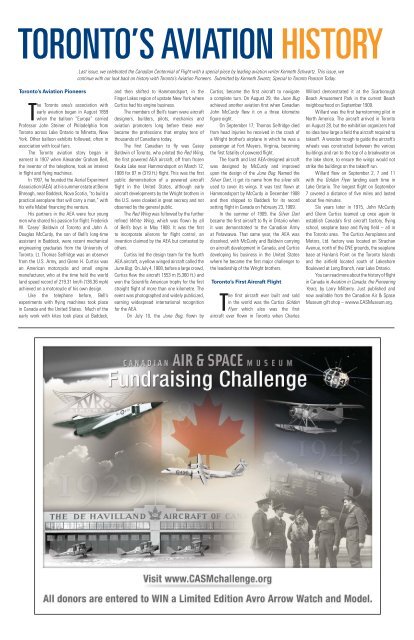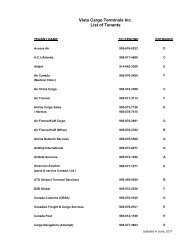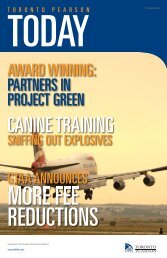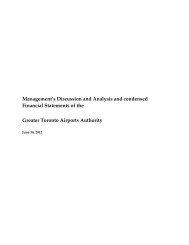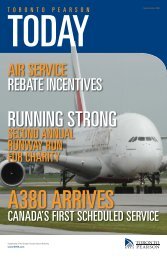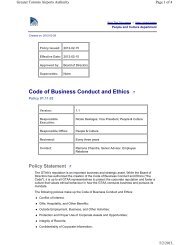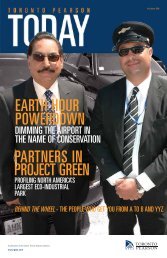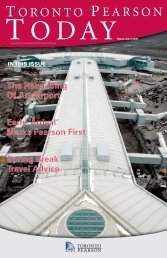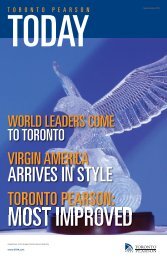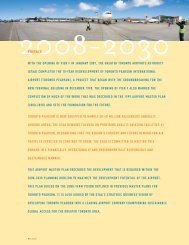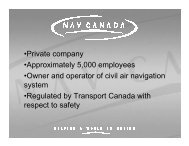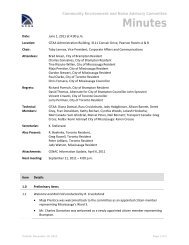Lights out - Toronto Pearson International Airport
Lights out - Toronto Pearson International Airport
Lights out - Toronto Pearson International Airport
Create successful ePaper yourself
Turn your PDF publications into a flip-book with our unique Google optimized e-Paper software.
TORONTO’S AVIATION HISTORY<br />
Last issue, we celebrated the Canadian Centennial of Flight with a special piece by leading aviation writer Kenneth Schwartz. This issue, we<br />
continue with our look back on history with <strong>Toronto</strong>’s Aviation Pioneers. Submitted by Kenneth Swartz, Special to <strong>Toronto</strong> <strong>Pearson</strong> Today.<br />
<strong>Toronto</strong>’s Aviation Pioneers<br />
The <strong>Toronto</strong> area’s association with<br />
early aviation began in August 1859<br />
when the balloon “Europa” carried<br />
Professor John Steiner of Philadelphia from<br />
<strong>Toronto</strong> across Lake Ontario to Minetto, New<br />
York. Other balloon exhibits followed, often in<br />
association with local fairs.<br />
The <strong>Toronto</strong> aviation story began in<br />
earnest in 1907 when Alexander Graham Bell,<br />
the inventor of the telephone, took an interest<br />
in fl ight and fl ying machines.<br />
In 1907, he founded the Aerial Experiment<br />
Association (AEA) at his summer estate at Beinn<br />
Bhreagh, near Baddeck, Nova Scotia, “to build a<br />
practical aeroplane that will carry a man,” with<br />
his wife Mabel fi nancing the venture.<br />
His partners in the AEA were four young<br />
men who shared his passion for fl ight. Frederick<br />
W. ‘Casey’ Baldwin of <strong>Toronto</strong> and John A.<br />
Douglas McCurdy, the son of Bell’s long-time<br />
assistant in Baddeck, were recent mechanical<br />
engineering graduates from the University of<br />
<strong>Toronto</strong>. Lt. Thomas Selfridge was an observer<br />
from the U.S. Army, and Glenn H. Curtiss was<br />
an American motorcycle and small engine<br />
manufacturer, who at the time held the world<br />
land speed record of 219.31 km/h (136.36 mph)<br />
achieved on a motorcycle of his own design.<br />
Like the telephone before, Bell’s<br />
experiments with fl ying machines took place<br />
in Canada and the United States. Much of the<br />
early work with kites took place at Baddeck,<br />
and then shifted to Hammondsport, in the<br />
Finger Lakes region of upstate New York where<br />
Curtiss had his engine business.<br />
The members of Bell’s team were aircraft<br />
designers, builders, pilots, mechanics and<br />
aviation promoters long before these ever<br />
became the professions that employ tens of<br />
thousands of Canadians today.<br />
The first Canadian to fly was Casey<br />
Baldwin of <strong>Toronto</strong>, who piloted the Red Wing,<br />
the fi rst powered AEA aircraft, off from frozen<br />
Keuka Lake near Hammondsport on March 12,<br />
1908 for 97 m (319 ft.) flight. This was the first<br />
public demonstration of a powered aircraft<br />
fl ight in the United States, although early<br />
aircraft developments by the Wright brothers in<br />
the U.S. were cloaked in great secrecy and not<br />
observed by the general public.<br />
The Red Wing was followed by the further<br />
refi ned White Wing, which was flown by all<br />
of Bell’s boys in May 1908. It was the first<br />
to incorporate ailerons for flight control, an<br />
invention claimed by the AEA but contested by<br />
others.<br />
Curtiss led the design team for the fourth<br />
AEA aircraft, a yellow winged aircraft called the<br />
June Bug. On July 4, 1908, before a large crowd,<br />
Curtiss fl ew the aircraft 1553 m (5,360 ft.) and<br />
won the Scientific American trophy for the first<br />
straight fl ight of more than one kilometre. The<br />
event was photographed and widely publicized,<br />
earning widespread international recognition<br />
for the AEA.<br />
On July 10, the June Bug, flown by<br />
Curtiss, became the first aircraft to navigate<br />
a complete turn. On August 29, the June Bug<br />
achieved another aviation first when Canadian<br />
John McCurdy flew it on a three kilometre<br />
figure eight.<br />
On September 17, Thomas Selfridge died<br />
from head injuries he received in the crash of<br />
a Wright brother’s airplane in which he was a<br />
passenger at Fort Meyers, Virginia, becoming<br />
the first fatality of powered flight.<br />
The fourth and last AEA-designed aircraft<br />
was designed by McCurdy and improved<br />
upon the design of the June Bug. Named the<br />
Silver Dart, it got its name from the silver silk<br />
used to cover its wings. It was test flown at<br />
Hammondsport by McCurdy in December 1908<br />
and then shipped to Baddeck for its record<br />
setting flight in Canada on February 23, 1909.<br />
In the summer of 1909, the Silver Dart<br />
became the first aircraft to fly in Ontario when<br />
it was demonstrated to the Canadian Army<br />
at Petawawa. That same year, the AEA was<br />
dissolved, with McCurdy and Baldwin carrying<br />
on aircraft development in Canada, and Curtiss<br />
developing his business in the United States<br />
where he became the first major challenger to<br />
the leadership of the Wright brothers.<br />
<strong>Toronto</strong>’s First Aircraft Flight<br />
The first aircraft ever built and sold<br />
in the world was the Curtiss Golden<br />
Flyer which also was the first<br />
aircraft ever flown in <strong>Toronto</strong> when Charles<br />
Willard demonstrated it at the Scarborough<br />
Beach Amusement Park in the current Beach<br />
neighbourhood on September 1909.<br />
Willard was the first barnstorming pilot in<br />
North America. The aircraft arrived in <strong>Toronto</strong><br />
on August 28, but the exhibition organizers had<br />
no idea how large a field the aircraft required to<br />
takeoff. A wooden trough to guide the aircraft’s<br />
wheels was constructed between the various<br />
buildings and ran to the top of a breakwater on<br />
the lake shore, to ensure the wings would not<br />
strike the buildings on the takeoff run.<br />
Willard flew on September 2, 7 and 11<br />
with the Golden Flyer landing each time in<br />
Lake Ontario. The longest flight on September<br />
7 covered a distance of five miles and lasted<br />
ab<strong>out</strong> five minutes.<br />
Six years later in 1915, John McCurdy<br />
and Glenn Curtiss teamed up once again to<br />
establish Canada’s first aircraft factory, flying<br />
school, seaplane base and flying field – all in<br />
the <strong>Toronto</strong> area. The Curtiss Aeroplanes and<br />
Motors, Ltd. factory was located on Strachan<br />
Avenue, north of the CNE grounds, the seaplane<br />
base at Hanlan’s Point on the <strong>Toronto</strong> Islands<br />
and the airfield located s<strong>out</strong>h of Lakeshore<br />
Boulevard at Long Branch, near Lake Ontario.<br />
You can read more ab<strong>out</strong> the history of flight<br />
in Canada in Aviation in Canada: the Pioneering<br />
Years, by Larry Milberry. Just published and<br />
now available from the Canadian Air & Space<br />
Museum gift shop – wwww.CASMuseum.org.<br />
12 <strong>Toronto</strong> <strong>Pearson</strong> Today First Quarter 2009


